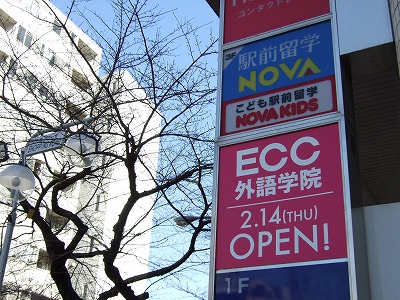Working As an English Teacher in Japan: Inside Japan’s English Conversation Schools
CONTENTS
The Truth About Japan’s English Conversation Schools
By Erik Tielking
This wasn’t supposed to happen. Nova Corporation, my employer for ten years in Japan, operated the nation’s largest chain of English conversation schools, or eikaiwa gakkō. It had been listed on the JASDAQ stock market since 2004. At its peak in 2005 it had 994 branches, yearly sales exceeding 70 billion yen (66 million $US) and something close to a 51% market share. Its cartoon spokesperson, a pink bunny with a yellow beak, was known and loved all over the country.
And yet in late 2007 the company was collapsing around us. For several years the company had been expanding too fast, spending vast sums on advertising and building a number of schools that failed to reach profitability. An investigation by the Ministry of Economy, Trade and Industry into certain business practices precipitated a wave of contract cancellations by students. Beginning in July salary payments to some employees started coming late. My own school lacked the funds even to buy copier paper or whiteboard markers. And then teacher salaries weren’t paid, and many teachers stopped coming to work. Students brought gifts of food to the teachers who remained at their posts. Finally on October 25th the board of directors dismissed the president; they filed for bankruptcy the next day.
Because Nova was subleasing apartments to many of its approximately 4,200 foreign employees, when the company went out of business quite a few people had to find alternative living arrangements quickly. I know at least one teacher who ended up moving in with one of his students.

Within days of the bankruptcy filing a company called G.education stepped in with the intention of taking over and reviving at least some of Nova’s schools, promising “in principle” to rehire all of Nova’s employees who wished to continue working. But they found it unexpectedly difficult to do so. Many teachers were rehired only to be let go a few months later. Other teachers were given offers to start work in January – offers which were then rescinded in a letter dated December 21st.
But the biggest financial losers were the estimated 300,000 students. Employees, including teachers, could apply to the government and receive about 80% of the approximately 6 billion yen (56 million $US) Nova owed them. But no such relief is available to the students, some of whom had prepaid for up to three years worth of lessons. Collectively they have lost about 56 billion yen (528 million $US). G.education has offered them a deep discount on the price of lessons at the new Nova branches. I personally know students who have taken the company up on the offer and others who are washing their hands of Nova.
Back Ground
Although Japan is the second largest economy in the world, its land is blessed with few natural resources: the wealth of the nation is based upon international trade. Since English is the world’s lingua franca today, it is important that the Japanese people be able to use it, but in point of fact Japan ranks among the lowest countries in Asia in terms of the English ability of its citizens. In 2007 takers of the TOEFL (Test of English as a Foreign Language) in Japan scored lower than those in China, India, Indonesia, Malaysia, Myanmanr, Nepal, North Korea, South Korea, and Vietnam.
How is this possible? Virtually all Japanese adults have studied English in middle school and high school for a total of six years; those who went to a four-year university might have another two years on top of that.
But class sizes are usually fairly large, and the curriculum usually focuses on reading and grammar. As a result a large number of adults have a certain amount of English vocabulary left over from this process and at least a rudimentary ability to read, but very little ability to hold a conversation. People who actually want to be able to speak English, then, have to do some more work, and a significant industry exists to meet their needs. Users of a website by Oricon rank and comment on 50 different eikaiwa schools, but this is not meant to be an exhaustive list of all the English conversation schools in Japan. In 2007, foreign language schools posted sales of over 300 billion yen (about 2.8 billion $US), mostly for English-language instruction.
While my own direct experience with eikaiwa gakkō is limited to one company, that firm was the market leader for years, and it seems to be fairly representative of English conversation schools in Japan.
The Teachers
At Nova all instructors were native speakers of English. Almost all were recruited from overseas, and few could speak Japanese. Few had any prior training or experience in ESL teaching; the only real qualification for the job besides being a native speaker was being eligible for a work visa. For most instructors this simply meant holding a bachelor’s degree, in any subject.
Most instructors did not stay very long. Once I did a shift at a small branch in Tokyo where I met a fellow who had been at Nova for 18 months. It seems that in all that time he had never met another teacher, aside from those who gave him his initial training, who had been with the company as long as a year and a half. (Until he met me, that is; at that time I was in my third year at Nova. He seemed disappointed to learn that.)
The teachers I worked with typically made sure to get in as much travelling, sightseeing, and partying as they could while in Japan. Most were teaching English because they wanted to see another part of the world, not because they thought of themselves as teachers. There were exceptions, but these made up a small proportion of the instructors I met.
Much of this seems to apply to other schools as well. Keiko, a young woman who has studied at four different eikaiwa schools, told me that most of the teachers she met seemed to be “on vacation”, not seriously pursuing a career. “After a couple of years you could see that they weren’t enjoying it any more, and eventually they went back to their own country.” I also talked to a Berlitz teacher who noted the high turnover rate where she works. “Most teachers at my school seem to see this job as a means to an end, for example to save money…. Most teachers seem to stay three or four years at most.”
The Japanese Staff

Upon walking into a Nova school one was cheerfully greeted by a Japanese staff member, usually a pretty young woman in a dark suit. Japanese employees handled sales and administration at the school level and above. Almost all were female and almost all could speak English – some very well. According to Tomoko, a Nova employee for a little over two years, the average age of her Japanese co-workers was around 25, compared to an average for the Japanese workforce as a whole of around 35. She also informed me that the average tenure for a Japanese staff member was about two years.
These women had to work very hard. They often worked six days a week, and they put in overtime practically every day; Tomoko said that while a late shift theoretically ended at 9 pm, she usually didn’t leave the school until around 11 pm or so. And it was very difficult to take one’s paid holidays, leading people to complain that “Nova” was actually short for “no vacation.”
She says, the staff received thorough training in the sales aspect of their job, though perhaps not so much in the other aspects of it. “We were like sales machines” she says.
Nova students would occasionally mention to me that the sales staff could be a bit pushy at times. Keiko assures me that this is also true at other schools; while in theory part of their job is to counsel students in how to get the most from their lessons, “staff generally are just thinking about sales, not about my English. At four schools, only one staff member ever actually gave me useful advice on studying English, based on her own experience.”
“We students could tell the staff were thinking about (getting the student to sign) the contract first, not the student first. And that’s not fun. They would sell more if they put us first,” she says.
My contact at Berlitz tells me that the Japanese staff at her company also are mostly women who can speak English. And I once spotted a help-wanted ad seeking sales/administrative staff for an English conversation school in Tokyo; it noted that the staff members there got only three days off every two weeks.
The Students

At Nova I taught a fairly wide variety of students, ranging in age from 13 to 75 years. I met a sculptor, a fashion designer, a police officer, an underwater construction worker, several flight attendants, a student at a hair design school, an aircraft maintenance person, the captain of a minesweeper, and several small business owners, to mention only a few. I even taught English to a couple of high school English teachers; one was pretty good at the language, but the other was embarrassed to admit what it was she did for a living.
Many of my students either needed English for work or expected to do so in the future. A number of them regularly communicated in English by e-mail, or frequently had to read English documents at work, but would actually get to talk to someone in English only rarely; they came to Nova to keep their speaking skills up. Other students worked in companies where English ability was a requirement for promotion above a certain level. My Berlitz contact tells me that most of her students are mid- to high-income professionals who are studying for work reasons.
Many other students told me they wanted to be able to speak English when travelling overseas. Still others were interested in English-language TV programs or movies; one told me he was a fan of rap music. One very energetic student who was on his company’s American football team had become interested because of the sport he played. I met one young woman who wanted to be able to communicate with her future in-laws, and an older gentleman who had grandchildren in America who did not speak Japanese.
All different sorts of people, of different ages and different walks of life, come together for a common purpose at an eikaiwa school. For Ms. P, an avid student, “It’s a chance to talk to people I usually wouldn’t get to meet.” She tells me she’s made a lot of friends in her English classes. Akiko, a former Nova student, says she still keeps in touch with some of the people she used to study English with.
The Lessons

I’m sure that at the interview in Boston I was told that I would be teaching eight 40- or 45-minute lessons every day, with 10-minute breaks in between. I imagine it was mentioned that during those 10-minute breaks I would write comments about the performance of each student in the previous class, put those students’ files away, find the files of the students in my next class, choose a unit in the textbook to teach them, and then prepare for that lesson. But somehow it didn’t sink in just how hectic of a teaching schedule that would be. For most lessons there was next to no time available to prepare.
The lack of prep time meant that for most lessons I could do little but follow the textbook through the lesson steps I’d been taught in initial training. I was teaching the material pretty much the same way everybody else did, and much the same way from unit to unit. In theory the small-group classes our company offered meant students could get individual attention and instruction tailored to their needs, but in fact the lack of preparation time meant most lessons would be taught on the standard pattern no matter who was sitting in front of me.
Lack of training didn’t help either; as mentioned before most of us had no prior experience teaching ESL, and initial training at Nova was only three days long. Berlitz gives new instructors ten days of initial training. But considering that English language teachers working in universities generally have a master’s degree in teaching ESL, even a couple of weeks hardly seems adequate preparation.
I did learn a lot on the job. I learned a considerable amount about English grammar and usage from students asking me all sorts of questions about things I’d never thought about before. Over time I collected some (unapproved) supplemental materials to use with my lessons, and developed alternative ways to teach topics not covered in our texts and problem areas that kept cropping up again and again. Some instructors who had been teaching more than a decade basically didn’t use the textbook any more, having put together a great deal of their own material and developed extremely flexible ways of using it. The students I spoke to said they greatly appreciated the efforts of these teachers.
The Results
Eikaiwa schools seem to serve some students fairly well. Ms. P used to take Nova lessons several times a week after a trip to Walt Disney World in Florida five years ago inspired her to try to learn so she could talk to the people she meets on her travels. “When I started I couldn’t say much beyond ‘Hello’, ‘Excuse me’, and so forth. But now when I go on an overseas vacation I can enjoy talking with the locals and the other tourists.”
But not all students are as satisfied. Akiko spent about five years at Nova also, taking one or two lessons a week. During that time she took the TOEIC (Test of English for International Communication) twice, three years apart. Her score was the same each time. But late last summer she moved to a different division of her company in which she has to work with foreigners, mostly in English, quite frequently. After about five months of this she took the test again, and this time her score was twenty-five points higher. “Five months at my current job, using English every day, has improved my English ability more than five years at Nova did.”
For Ms. H, another former student, “The most mysterious thing about the eikaiwa schools is this: why, when we are spending so much money and time studying at these places, can’t we all speak English?” Well, for every student the answer might be different, and the situation at every school is not identical either. I’ll let the readers draw their own conclusions from what I’ve seen and heard.
The job did have its rewards for me. I remember once coming back to work after lunch and passing a young man signing in at the counter. I took a second look, and remembered that when I first met him he was just thirteen years old, and could barely say more than “Hello” and “How are you?” Now, six years later, he was able to express himself quite fluently in English. He was hoping to do part of his university education overseas, and I was confident that he had the linguistic means to do so. I felt pretty good about being part of the reason he was in a position to pursue his ambitions.


